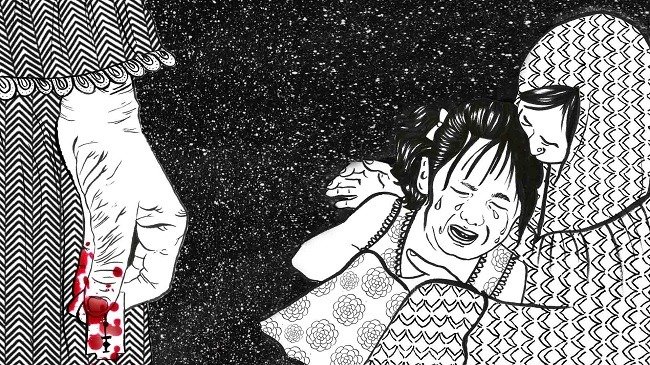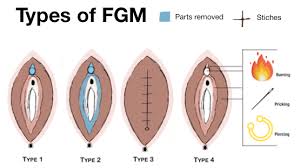This article has been written by Priyanka Bajpai , 1st year student of Amity Law School , Chhattisgarh .
FEMALE GENITAL MUTILATION
We all have had cuts once in our lifetime and somewhere or the other felt pain. What if there’s a cut or a stitch on your body’s most sensitive part? Well , we would barely even imagine it. Alas! but certain girls take this pain too. Getting cuts in your vagina and then getting it stitched wholly, that’s the actual pain. That’s what happen in Female Genital Mutilation , a cultural practice that is no less than a curse !
What is Female Genital Mutilation?
WHO explained Female Genital Mutilation as[1] –
- It includes the total or partial removal of external female genitalia . It is referred to be an injury to the female genital organs for non-medical reasons.
- This practice has no health benefits for girls and women.
- FGM is mostly carried out on girls between infancy and age 15.
- This unnecessary practice does no good , in contrary , harms the most. FGM can cause severe bleeding and problems urinating , and later cysts. It also causes infections and further complications in child birth and increased risk of new born deaths.
- More than 200 million girls and women alive today have been cut. This practice is mostly followed in Africa , Middle East and Asia.
This issue is extremely important and sensitive. This practice is followed and carried out by traditional circumcisers, who play other roles in communities like handling other cultural practices and attending child births. This practice of making cuts and stitches are often done by health workers considering it be safe because it is by trusted source. WHO has also strictly recommended the health workers NOT TO perform these activities, not to work for FGM.
Due to FGM , multiple complications occur in women’s body. This practice even lead to immediate complications like that of hemorrhage and excessive bleeding.
Why is FGM performed on women and girls?
FGM is mostly performed on young girls between infancy and adolescence and even on adult women. This painful process does no good to girls and is vague. Giving such an inhuman act a name of culture is unacceptable. It is an attempt to control women’s sexuality and their experience of sexual pleasure.
“It has been a part of our lives and will be continue to be part of our generations”, that’s what they say about performing these activities. The need to remove such customs is the most important factor for now. This can only be done through laws enacted against such an act.
Major problems caused due to FGM are:
- Vaginal infection
- Urinary infection
- Prevents from getting pregnant as this practice would lead to infertility.
- HIV due to use of same knife or blade.
- Pain during sexual intercourse
- Pain during menstruation days.
- complications in child birth causing death of child and mother.
Types of Female Genital Mutilation
Type1. Removal of clitoris partially or fully.
It includes the removal of clitoral glans, sensitive part of female genital. It also includes the removal of the skin fold surrounding clitoris.
Type2. Removal of Labia Minora (inner walls of vulva) .
It includes the removal of clitoris and the removal of Labia Minora also known as the inner folds.
Type3. Removal of all, creation of covering seal.
It is the removal of the rest parts including the Labia majora. It further includes the creation of vaginal covering seal through narrowing the vaginal opening and edges are stitched together. It is done through stitching the Labia Majora with each other. Leaving a tiny opening for menstrual flow and urination.
Type4. Unclassified , other harmful process to female genitalia .
It includes piercing the area, introduction of corrosive material, tattoo, etc.
Human rights violated by FGM.
WHO has also recognized FGM as violation of human rights. It refers to the violation of right to life under article 21 that suggests, ‘right to life and personal liberty’, which includes right to live with dignity. Living with this practice being followed, living life with dignity is hindered.
It is also violation of child rights. It also increases the inequality amongst sexes. This act also hinders the right of human to live free from inhuman activities like these.
Is FGM practiced in India ?[2]
Female Genital mutilation is practiced in India and is known as Khatna or Khafz. This practice is common amongst the Bohra Community , whose members live in Maharashtra, Madhya Pradesh, Kerala, Gujarat and Rajasthan.
According to a study, in 2018, by WeSpeakOut, a survivor led moment, it was known that 75% of girls or women of Bohra community had went through this practice of FGM. Most of the women showed and described negative effects of FGM. It also caused long term psychological harm.
The Bohra Community members have started taking steps against this practice and have started rejecting to cut their daughters for the sake of a cultural practice.
FGM in other countries.
Female Genital Mutilation is a major concern worldwide. According to survey by UNICEF , 29 Countries in Africa are practicing FGM . The culture and practice, to follow it, has to be reduced and steps are taken against this. This practice needs to be band globally.
Sudan has brought laws against FGM. It has finally contributed towards the safety of rights. It has criminalized Female Genital Mutilation and now have stricter laws against it. Imprisonment for 3 yrs and fine is the noted punishment.
Conclusion
Female Genital Mutilation has to be stopped. Such practices are against human rights and are threat to society’s existence and needs to be waved off. Countries all together should actively take part and amend laws for stopping such horrendous act. Practice like FGM is a blot on human life. The way in which, cultural practices like Sati and Johar were permanently removed from the society, FGM has to end and our women and girls have to be protected.
References:
[1] https://www.who.int/news-room/fact-sheets/detail/female-genital-mutilation
[2] https://amnesty.org.in/female-genital-mutilation-in-india/
Image from shethepeople



